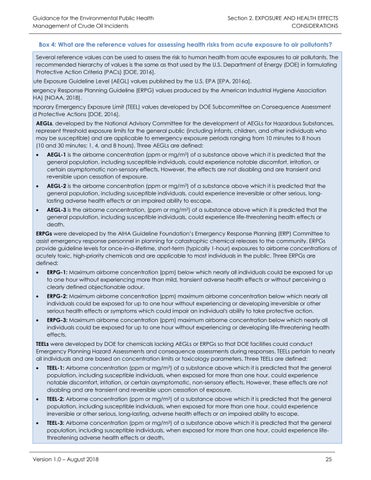Guidance for the Environmental Public Health Management of Crude Oil Incidents
Section 2. EXPOSURE AND HEALTH EFFECTS CONSIDERATIONS
Box 4: What are the reference values for assessing health risks from acute exposure to air pollutants? Several reference values can be used to assess the risk to human health from acute exposures to air pollutants. The recommended hierarchy of values is the same as that used by the U.S. Department of Energy (DOE) in formulating Protective Action Criteria (PACs) [DOE, 2016]. cute Exposure Guideline Level (AEGL) values published by the U.S. EPA [EPA, 2016a]. mergency Response Planning Guideline (ERPG) values produced by the American Industrial Hygiene Association HA) [NOAA, 2018]. mporary Emergency Exposure Limit (TEEL) values developed by DOE Subcommittee on Consequence Assessment d Protective Actions [DOE, 2016]. AEGLs, developed by the National Advisory Committee for the development of AEGLs for Hazardous Substances, represent threshold exposure limits for the general public (including infants, children, and other individuals who may be susceptible) and are applicable to emergency exposure periods ranging from 10 minutes to 8 hours (10 and 30 minutes; 1, 4, and 8 hours). Three AEGLs are defined: •
AEGL-1 is the airborne concentration (ppm or mg/m3) of a substance above which it is predicted that the general population, including susceptible individuals, could experience notable discomfort, irritation, or certain asymptomatic non-sensory effects. However, the effects are not disabling and are transient and reversible upon cessation of exposure.
•
AEGL-2 is the airborne concentration (ppm or mg/m3) of a substance above which it is predicted that the general population, including susceptible individuals, could experience irreversible or other serious, longlasting adverse health effects or an impaired ability to escape.
•
AEGL-3 is the airborne concentration, (ppm or mg/m3) of a substance above which it is predicted that the general population, including susceptible individuals, could experience life-threatening health effects or death.
ERPGs were developed by the AIHA Guideline Foundation’s Emergency Response Planning (ERP) Committee to assist emergency response personnel in planning for catastrophic chemical releases to the community. ERPGs provide guideline levels for once-in-a-lifetime, short-term (typically 1-hour) exposures to airborne concentrations of acutely toxic, high-priority chemicals and are applicable to most individuals in the public. Three ERPGs are defined: •
ERPG-1: Maximum airborne concentration (ppm) below which nearly all individuals could be exposed for up to one hour without experiencing more than mild, transient adverse health effects or without perceiving a clearly defined objectionable odour.
•
ERPG-2: Maximum airborne concentration (ppm) maximum airborne concentration below which nearly all individuals could be exposed for up to one hour without experiencing or developing irreversible or other serious health effects or symptoms which could impair an individual's ability to take protective action.
•
ERPG-3: Maximum airborne concentration (ppm) maximum airborne concentration below which nearly all individuals could be exposed for up to one hour without experiencing or developing life-threatening health effects.
TEELs were developed by DOE for chemicals lacking AEGLs or ERPGs so that DOE facilities could conduct Emergency Planning Hazard Assessments and consequence assessments during responses. TEELs pertain to nearly all individuals and are based on concentration limits or toxicology parameters. Three TEELs are defined: •
TEEL-1: Airborne concentration (ppm or mg/m3) of a substance above which it is predicted that the general population, including susceptible individuals, when exposed for more than one hour, could experience notable discomfort, irritation, or certain asymptomatic, non-sensory effects. However, these effects are not disabling and are transient and reversible upon cessation of exposure.
•
TEEL-2: Airborne concentration (ppm or mg/m3) of a substance above which it is predicted that the general population, including susceptible individuals, when exposed for more than one hour, could experience irreversible or other serious, long-lasting, adverse health effects or an impaired ability to escape.
•
TEEL-3: Airborne concentration (ppm or mg/m3) of a substance above which it is predicted that the general population, including susceptible individuals, when exposed for more than one hour, could experience lifethreatening adverse health effects or death.
Version 1.0 – August 2018
25







